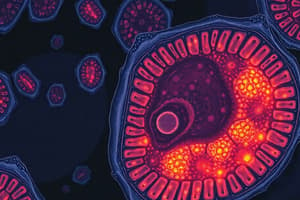Podcast
Questions and Answers
What is the primary focus of cell biology?
What is the primary focus of cell biology?
- Exploring the structure and functions of cells (correct)
- Investigating the role of cells in reproduction
- Understanding the role of cells in communication
- Studying the chemical composition of cells
In which century did cell biology emerge as a discipline?
In which century did cell biology emerge as a discipline?
- 18th century
- 21st century
- 19th century
- 20th century (correct)
What distinguishes plant cells from animal cells?
What distinguishes plant cells from animal cells?
- Lack of a nucleus
- Presence of mitochondria
- Presence of a rigid cell wall made of cellulose (correct)
- Ability to undergo reproduction
Which term describes the critical components within cells that carry out specific functions?
Which term describes the critical components within cells that carry out specific functions?
What are cells considered in the context of living organisms?
What are cells considered in the context of living organisms?
What is the function of the Golgi Apparatus?
What is the function of the Golgi Apparatus?
Which organelle is responsible for cellular respiration and ATP production?
Which organelle is responsible for cellular respiration and ATP production?
What is the function of the cell membrane?
What is the function of the cell membrane?
What is the primary function of lysosomes?
What is the primary function of lysosomes?
What is the study of cells and their structures known as?
What is the study of cells and their structures known as?
Study Notes
Unraveling the Wonders of Biology: Diving Deep into Cell Biology
On this enlightening journey through the vast world of biology, we'll be zeroing in on a fundamental subtopic: cell biology. Our 1000-word exploration will introduce you to the intricate workings of cells, our body's fundamental building blocks.
Cell Biology: A Revitalizing Discipline
Science's focus on cell biology has revolutionized our understanding of life's most basic elements. As a relatively new discipline, cell biology has grown rapidly since its inception in the 20th century, offering fresh insights into the incredible array of biological processes that enable life.
The Cell: The Building Block of Life
Cells are the tiny, structure-forming units of all living things. They act as the primary processing site for life's essential activities such as metabolism, reproduction, and communication. In plants, animals, fungi, and even bacteria, cells are the common denominator.
Three Types of Cells
Cells come in three different flavors: plant cells, animal cells, and bacteria cells (prokaryotes). These cells differ in structure, composition, and function. For instance, plant cells have a rigid cell wall made from cellulose, while animal cells lack this structure.
Organelles: The Cell's Hidden Powerhouses
Organelles are critical components within cells that carry out specific functions. Some key organelles include:
- Protonoplast: An energy-producing unit that houses the mitochondrion, responsible for cellular respiration and ATP (adenosine triphosphate) production.
- Endoplasmic Reticulum: A vast membranous network involved in protein synthesis, lipid metabolism, and calcium storage.
- Golgi Apparatus: A sorting and packaging center that processes proteins and lipids for transport to their correct cellular destinations.
- Lysosomes: Membrane-bound vesicles containing digestive enzymes that break down and recycle waste material.
The Cell Membrane: The Cell's Invisible Shield
The cell membrane is a semi-permeable barrier that regulates the movement of substances in and out of the cell. It's primarily composed of a lipid bilayer, along with various proteins and carbohydrates. The cell membrane plays a crucial role in cell signaling, cell-to-cell communication, and the maintenance of the cell's internal environment.
Cell Division and Growth
The process of cell division, or mitosis, is essential for growth, development, and repair. In mitosis, a single cell splits into two identical daughter cells, each containing the same number of chromosomes.
Cytology and Microscopy
Cytology is the study of cells and their structures, which often relies on microscopy to observe them. There are two primary types of microscopes used in cytology:
- Light microscopes: These devices use visible light to magnify specimens, such as in the case of a compound microscope or a confocal microscope.
- Electron microscopes: These microscopes utilize electron beams to magnify specimens, such as in the case of a scanning electron microscope (SEM) or a transmission electron microscope (TEM).
Applications of Cell Biology
Cell biology has numerous practical applications, including:
- Medicine: Understanding cell biology has led to advancements in treatments for various diseases, such as diabetes, cancer, and neurological disorders.
- Gene editing: CRISPR/Cas9 has revolutionized genetics, enabling precise editing of DNA sequences within cells.
- Food production: Cell biology helps develop new and sustainable food sources, such as lab-grown meats and plant-based proteins.
In conclusion, our exploration of cell biology has revealed the remarkable complexity of our cells and their pivotal role in sustaining life. By continuing to investigate the cells' numerous intricacies, researchers and scientists are able to unravel the secrets of life and apply their findings to improve our world. As we delve deeper into the wonders of biology, we're sure to encounter more remarkable discoveries and a deeper understanding of the incredible world around us.
Studying That Suits You
Use AI to generate personalized quizzes and flashcards to suit your learning preferences.
Description
Embark on a fascinating journey through cell biology, delving into the intricate workings of cells and their vital role as the fundamental building blocks of life. Explore the different types of cells, organelles, the cell membrane, cell division, microscopy, and practical applications of cell biology in medicine, gene editing, and food production.





